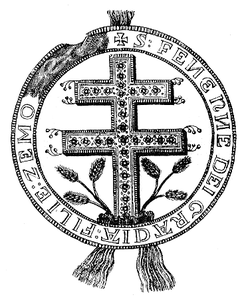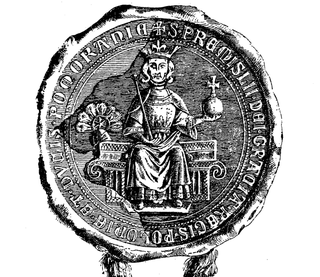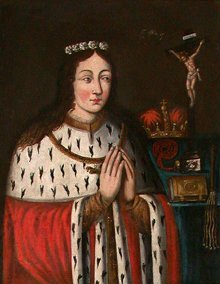Life
Birth and Name
Fenenna's parentage is confirmed in the Genealogia sanctae Hedwigis (literally: Genealogy of Saint Hedwig). The marriage of her parents is placed around the first half of February 1268. [2] If she was the oldest child of the ducal couple, she could have born at the end of that year. She was married in 1290, and in accordance with the Canonical Law of that time, the legal age to celebrate a marriage was 12 years old; but two years later, in 1292, she gave birth to her only child, probably at 15 years. Accordingly, her date of birth could be between 1268 and 1277. [3] Among the offspring of Duke Ziemomysł, Fenenna has been placed as the second child, between Euphemia (who died in infancy) and Leszek. [4]
Fenenna's name was chosen from the Bible (later translated by Jakub Wujek), as one of the two wives of Elkanah, father of the Prophet Samuel. [5] This uncommon name was rarely used in Poland, and Fenenna was the only member of the Piast dynasty who bore it. [6]
Queen of Hungary

The Genealogy of Saint Hedwig indicated that Fenenna was betrothed to the Hungarian king. According to Jan Długosz this Hungarian ruler was King Stephen V. Although this assumption was not supported by any sources could not be true because Stephen V died in 1272, it was maintained until the 18th century. [7] Her husband was King Andrew III, as confirmed by the Hungarian sources. From the period of her reign, between 1290–1295, there are several documents issued by the Queen of Hungary, who signed as Fenena, Fennena, or in short Fenenna F. Legends on Hungarian stamps[ clarification needed ] of 1291 certify that Queen Fenenna was Ziemomysł's daughter. Due to her marriage, the Polish Kingdom began to cooperate closely with the Hungarian ruler.
In July 1290 Andrew III was crowned King of Hungary. One of his first actions was the conclusion of an alliance with Poland, in particular with Duke Władysław I the Elbow-high. In September negotiations began and no later than 9 October Fenenna arrived in Hungary as Andrew's bride, escorted by the king's envoy Theodore Tengerdi. [8] From 1290 three documents were issued describing Fenenna as Andrew III's wife and Queen of Hungary. The marriage of Andrew III and Fenenna took place between September and 24 November 1290. Probably during the wedding ceremony, or shortly after, Fenenna was crowned as Queen of Hungary. [9]
The marriage was pursued by Fenenna's uncle, Władysław I the Elbow-high, who wanted allies for his fight for the Polish throne. The Hungarian-Kuyavian alliance proved beneficial to both parties. The Dukes of Kuyavia helped Andrew III to defeat Charles Martel of Anjou, who claimed the Hungarian throne after the death of his maternal uncle, King Ladislaus IV the Cuman, in 1290. In return, the Hungarians sent provisions and military support to Władysław I during his fight against King Wenceslaus II of Bohemia and Duke Henry III of Głogów. Documents issued by Andrew III from 1293 show that aid was sent to the Dukes of Kuyavia. These documents specify that Andrew recompensed two Hungarian men, Paul and Serafila, for help in winning Prędocin. In 1297 documents record that Władysław, with the help of the Hungarians, invaded Greater Poland and Silesia.
From the surviving contemporary documents, it is known that Fenenna did not play a great role in the Hungarian court. In 1292, Fenenna gave birth her only child, a daughter named Elizabeth.
Death and Aftermaths
The sources are silent about Fenenna's death. Therefore, the date of her death can be determined only on basis of the negotiations of King Andrew III with the Austrian court for his second marriage with Agnes of Habsburg, and the documents issued by both Fenenna and Agnes. Almost all the known sources place the wedding of King Andrew III with Agnes of Habsburg in Vienna on 13 February 1296. However, although the year is generally accepted, the exact day and months varied in a number of partly independent sources. Documents issued by the Queen of Hungary also contributed to the confusion. The last document issued by Fenenna was dated 8 September 1295, while the first document issued by Agnes was dated 1 May 1295. Since the marriage of Andrew III with the Austrian princess was in 1296, the document probably was incorrectly written and had to be moved back by one year. It is now accepted that Andrew III's wedding with Agnes of Habsburg was held in 1296. In consequence, Fenenna was certainly dead by the end of 1295; the place of her burial is unknown. [10] [11]
After Fenenna's death, Andrew III entered into an agreement with Władysław I's opponent, Wenceslaus II. As a part of this settlement, his daughter Elizabeth was engaged to the son and heir of the Bohemian king, the future Wenceslaus III, in 1298. However, this marriage was never realized. Wenceslaus instead married Viola Elisabeth of Cieszyn, but later he planned to divorce Viola and marry Elizabeth before he was assassinated.
When King Andrew III died in 1301, Elizabeth was taken by her stepmother Agnes to Austria and forced to join the Dominican monastery in Töss, Switzerland, where she died in 1338 as the last representative of the Arpad dynasty.








